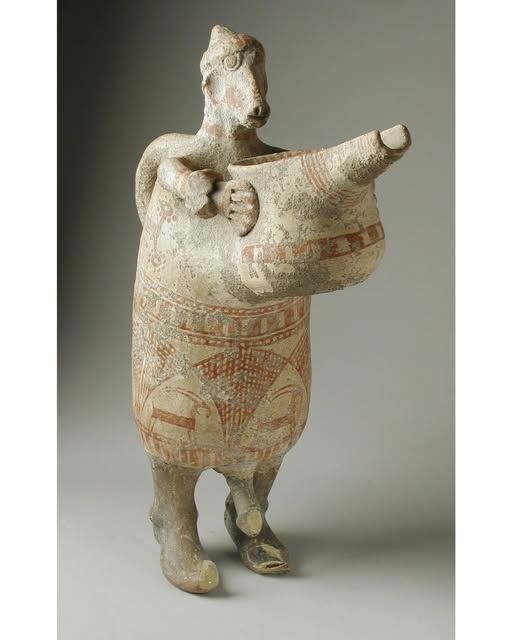This ancient artifact, a spouted vessel hailing from Western Iran, offers a captivating glimpse into the artistic and symbolic world of a civilization over 2,600 years ago. Its unique design, seamlessly blending human and animal forms, speaks to the ingenuity and creative spirit of its creators.

A Testament to Ancient Craftsmanship: Buff Ware Ceramic
Crafted from buff ware ceramic, the vessel showcases the advanced ceramic techniques of the time. The material, known for its pale yellowish-brown color, lends a natural and earthy aesthetic to the artifact.
- The careful shaping and firing of the clay demonstrate a high level of craftsmanship.
- The vessel’s well-preserved state speaks to the durability of the material and the skill of its creators.
A Fusion of Forms: Human and Animal Symbolism
The vessel’s most striking feature is its integration of human and animal characteristics, a design choice that likely held deep symbolic significance.
- The stylized human form, incorporated into the vessel’s structure, suggests a connection to human representation and perhaps ritualistic use.
- The animalistic features, though not explicitly defined, hint at the importance of the natural world and its creatures in the culture that created this artifact.
- This blending of human and animal forms is a reoccurring theme in many ancient cultures, and likely represent a connection to the spiritual world.
A Window into Ancient Iranian Culture: Size and Context
Measuring 28.5 x 9.5 cm (11.5 x 3.75 in), the vessel’s dimensions provide insight into its potential function and context.
- Its size suggests it may have been used for ceremonial or ritualistic purposes, perhaps for pouring liquids or offering libations.
- The spouted design further supports this theory, indicating its use in controlled pouring.
- Artifacts like this are invaluable for historians and archeologists to understand the daily life, beliefs, and artistic styles of ancient people.
A Legacy Preserved: The Los Angeles County Museum of Art
Today, this remarkable vessel resides at the Los Angeles County Museum of Art (LACMA) in California, where it serves as a testament to the rich artistic legacy of ancient Iran.
- Its presence at LACMA allows visitors to connect with the history and artistry of a distant civilization.
- The generous gift from Nasli M. Heeramaneck ensures that this artifact will continue to educate and inspire future generations.
- LACMA plays a vital role in preserving and showcasing cultural treasures from around the world.
A Timeless Enigma: Unraveling the Past
This spouted vessel, with its fusion of human and animal forms, remains an enigma, its exact purpose and symbolism lost to time. However, its existence provides a valuable window into the artistic ingenuity and cultural complexity of ancient Western Iran. It serves as a reminder of the enduring power of art to connect us with the past and inspire our imagination.

CÁC TIN KHÁC
Mary Walton: The Forgotten Inventor Who Helped Clean Up America’s Cities
Tomb of Queen Nefertari in the Valley of the Queens, Egypt
Discover the Hypostyle Hall of the Temple of Hathor at Dendera
Venus de Losange: Unveiling the Mystery of a 20,000-Year-Old Paleolithic Icon